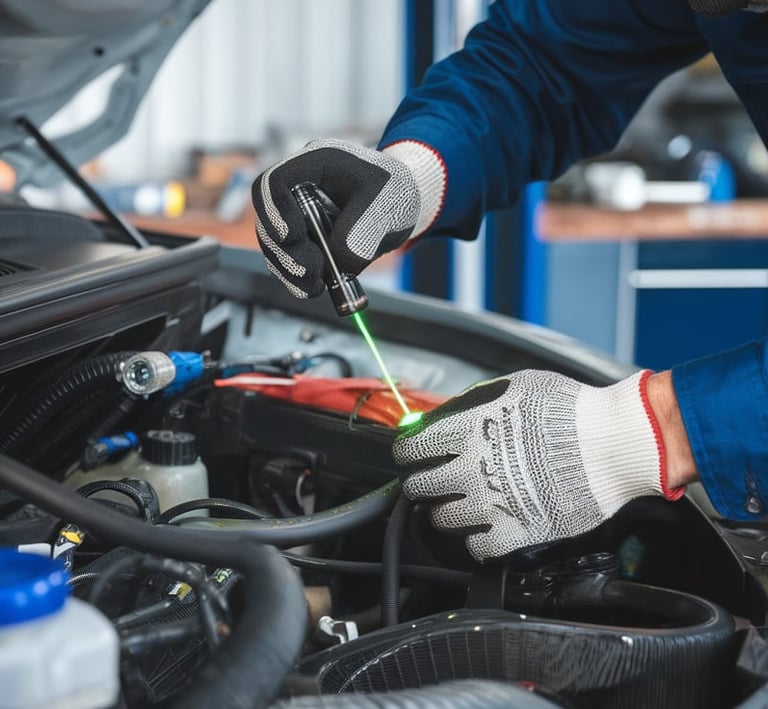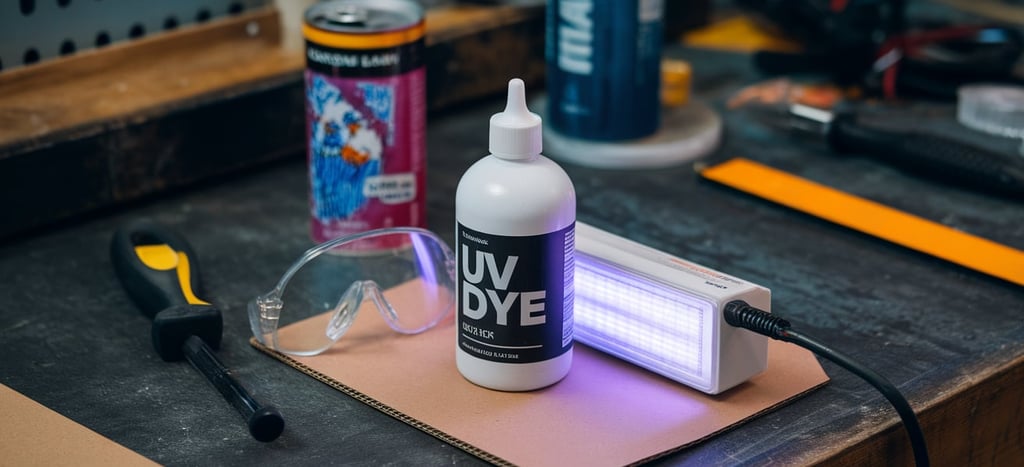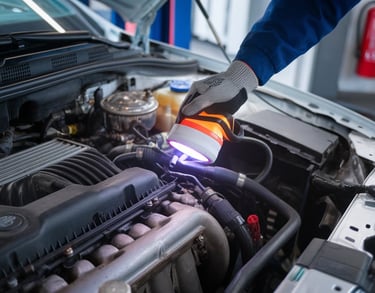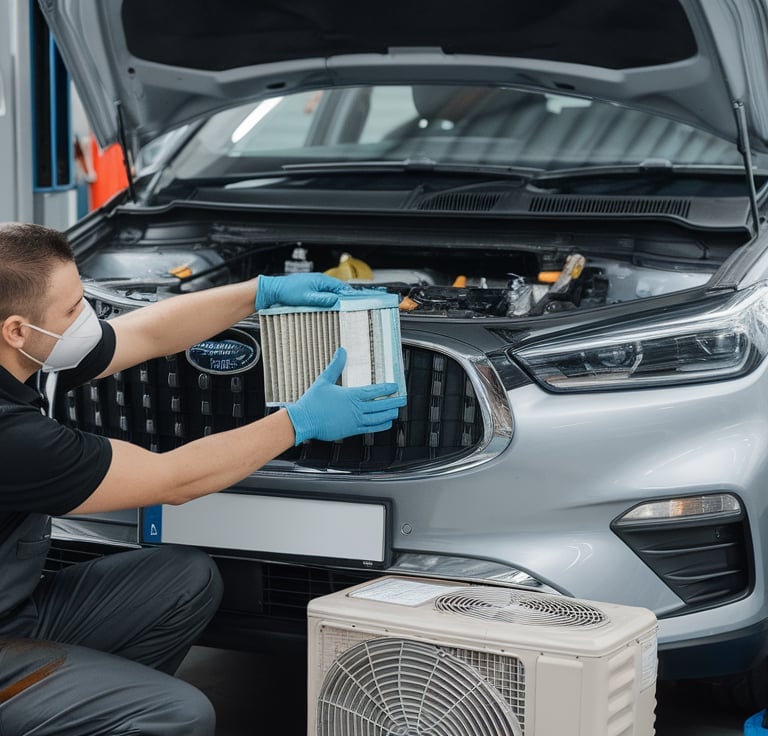How UV Dye Kits Reveal Hidden AC Leaks in Seconds
When Cool Air Stops Flowing, But the Fix Isn’t Obvious. In Dubai’s heat, an AC failure isn’t just annoying. It’s urgent. But not every leak leaves an oily trail or hissing sound. That’s why workshops rely on UV Leak Detection, a smarter, faster method to catch what the naked eye misses. A small dose of UV dye is added to the refrigerant. Once the AC runs, any escaping fluid glows under UV light, no dashboard tear-downs, no guessing. It’s the cleanest way to carry out AC system diagnostics, especially in luxury cars where precision matters. From quick AC leak service checks to deep refrigerant leak identification, UV dye kits for cars are now standard across serious garages. If you’re not using it, you’re likely missing the leak.
8/18/20259 min read
Why AC Leaks Matter in Dubai’s Climate and Luxury Car Market?
In Dubai, When AC Fails, It Is Not Just an Inconvenience. Every summer mile in Dubai feels like a test. And when the air conditioning cuts out, it does not just mean discomfort; it risks AC system failure. What makes things worse? Most leaks do not announce themselves. There is no puddle, no noise, just quiet refrigerant loss until the system runs dry and the compressor gives up.
Luxury vehicles amplify that risk. These systems are precision-built, layered with sensors and smart valves. One undetected leak? You could be staring at a four-figure repair. Add in Dubai’s relentless heat and dust, and you have a perfect storm where even minor climate impact can stress your AC beyond recovery.
That is why UV Leak Detection is no longer “extra.” It is the first step in responsible Dubai car AC repair. You inject a fluorescent dye, run the AC, and the escaping refrigerant glows under UV light. Leak found, downtime avoided. Professionals swear by UV Leak Detection, especially for luxury vehicle AC issues, where precision beats trial and error every time.
How Accurate Is UV Leak Detection in AC Systems?
In the world of high-pressure refrigerants and microscopic leaks, UV Leak Detection stands as one of the most precise and efficient diagnostic methods when used correctly. Here’s what separates smart usage from guesswork:
Pinpoint vs. Passive Detection
Unlike pressure drop tests or soap bubble methods, UV dye actively traces the leak path over time. The dye bonds with the system oil and leaks out exactly where the refrigerant escapes, making it a visible footprint of the problem.
Accuracy Factors
System Pressure: High-pressure environments yield clearer leak trails
Dye Concentration: Overdosing leads to staining; precise dosing is key
Inspection Timing: Early checks may miss slow leaks, 48-hour cycles allow full circulation
While effective for most systems, UV dye may struggle with:
Micro-leaks on rubber hoses or O-rings under low pressure
Leaks blocked by grime or insulation layers
Limits of Detection
Still, in workshop conditions, especially when servicing European luxury or hybrid units, UV remains the gold standard for initial leak confirmation before escalation to nitrogen/hydrogen sniffers. By pairing UV with expert technician workflows and post-repair flushing, workshops can guarantee not just detection but precision-backed diagnosis. That builds trust and protects assets and our car AC leak detection service in Dubai ensures your system stays in peak condition.
How UV Dye Kits Work | Precision Over Guesswork
Inside a workshop built for the Dubai market, AC leak detection is not just routine; it is about saving time, components, and client trust. That is where UV Leak Detection becomes the technician’s go-to tool. The process is methodical, not messy. Here is how trained pros use UV dye kits to trace leaks with zero guesswork: Technician Workflow UV Leak Detection Process


System Prep
The AC system is turned off. Pressure levels are noted. No shortcuts, technicians check refrigerant charge first to avoid diluted dye results.UV Dye Injection
A precise amount of dye is introduced into the low-pressure side. This tracer dye bonds with refrigerant and oil without affecting performance. It is formulated for full system compatibility, especially in high-end climate control units.Circulation Phase
The AC runs for 15–30 minutes. That allows tracer dye circulation through every pipe, valve, joint, and evaporator core.Black Light Inspection
After shutdown, a UV flashlight (not your average store-bought gear) reveals any leaks. The dye fluoresces, bright, unmistakable. Refrigerant tracing becomes visual and exact.Confirmation and Repair
Once a leak is spotted, technicians recheck with additional pressure tests before sealing or replacing. No second-guessing, no “hope it holds.”
UV Dye Kits That Work & Why Compatibility Isn’t Optional
In high-end AC service, especially across Dubai’s luxury car market, technicians do not touch AC dye kits until they’ve verified full refrigerant compatibility. R-134a systems? Hybrid setups? Electric compressors? Each demands its formula. Using the wrong kit means false readings, residue buildup, or worse, system damage.
That is why professional UV Leak Detection revolves around refrigerant-specific kits. Universal dyes exist, yes, but top-tier workshops avoid one-size-fits-all approaches. Instead, they stock:
R-134a-Compatible Dyes — ideal for most vehicles pre-2017 R-1234yf Kits, mandatory for newer systems with tighter tolerances
Hybrid/Electric Vehicle Dyes — non-conductive, safe for sensitive compressors
The process does not stop at the dye. Precision tools matter:
UV Flashlights — high-intensity, wavelength-calibrated for deeper visibility
Detection Glasses — polarized and tinted to cut glare and amplify fluorescence
Injection Syringes — calibrated for low-volume systems, especially in compact AC units
Consumer-grade kits? Not here. In Dubai, luxury AC diagnostics run on accuracy, not shortcuts. UV Leak Detection is only as good as the kit and tools behind it, and pros know the difference. UV Leak Detection matters most when system integrity is non-negotiable.
Why Not All UV Dye Kits Are Created Equal?
In Dubai’s premium garages, UV Leak Detection is only as effective as the dye kit behind it. You can have the best flashlight in the world, but if your dye lacks fluorescence intensity or interferes with oil properties, you’re working blind. And that’s how misdiagnoses happen.
So what defines a high-performance kit? Technician-Approved Features: UV Dye Kits That Deliver
Fluorescence Intensity
The dye must glow clearly under UV light, even in dusty bay environments. Dim dye? Missed leak.Oil Mixability
It needs seamless blending with PAG, POE, or mineral oils. If it separates or settles, detection accuracy drops fast.Detection Accuracy
No residue, no false glow. Quality dyes illuminate leaks and only leaks. That’s why pros trust AC leak detection tools field-tested in real vehicles.UV Dye Visibility
Should persist long enough for inspection, yet clear out cleanly during system flush. Overstayers risk sensor interference in luxury AC systems.
Compatibility matters too. Kits must match refrigerant type and system design, especially in electric or hybrid compressors. That is why most workshops in Dubai stick to UV Leak Detection products that undergo real-world tests before hitting the market. Because UV Leak Detection is not just a tool, it is the technician’s truth serum.


AC Leaks Aren’t Random | They Follow the Weak Links
In luxury vehicles, especially under Dubai’s punishing climate, AC leak points show up where pressure, vibration, and material stress intersect. Technicians trained in UV Leak Detection do not just look; they target the zones most prone to failure. The fluorescent dye does not guess; it glows where the refrigerant escapes. Here is where it usually shows up: Common Leak Locations | AC System Inspection Breakdown
Compressor Shaft Seals
The rotating shaft is a high-friction zone. If the seal wears, UV dye seeps out around the pulley, visible under UV Leak Detection in seconds.Condenser Welds & Tubes
Dubai’s heat plus road vibration means weld fatigue. UV dye clings to micro-cracks and reveals leaks without dismantling the front fascia.Evaporator Leaks (Behind Dash)
Tricky to access, but the dye shows up in drain outlets or air vents, an AC system inspection with a black light confirms the diagnosis.Service Valve Cores
Tiny, threaded components are often ignored. Dye glows around rubber seals when valve cores degrade.Hose Couplings & O-Rings
Age and pressure eat away at seals. UV dye tracks the path of the refrigerant, especially around hose cracks and junction points.Accumulator or Receiver-Drier
Internal corrosion leads to pinhole leaks. The dye collects around weld beads and inlet pipes.
With UV Leak Detection, every point becomes inspectable. Technicians walk the system top to bottom, not just once, but twice, because the dye does not lie. And in luxury AC setups, accuracy means everything.
Not All Leak Detection Methods Are Created Equal | Here’s Why UV Stands Out
In Dubai’s high-stakes AC service industry, accuracy is everything. And when it comes to AC leak detection comparison, pros have choices, but not all deliver the same clarity or efficiency. Let’s break it down. AC Leak Detection Methods Technician-Level Comparison
Electronic Leak Detectors: These sniffer tools sense chemical changes near a leak site. While fast and portable, they are sensitive to wind, humidity, and ambient refrigerant. Misfires happen often in open bays.
Nitrogen Pressure Testing: A traditional method uses dry nitrogen to pressurize the AC system. Any drop indicates leakage. Good for confirming presence, not for pinpointing location. No visual aid, just numbers.
UV Leak Detection: This method relies on fluorescent tracer dye injected into the AC system. Once circulated, escaping refrigerant glows under UV light. Clear. Visual. Exact. Technicians see the leak, not just sense it.
Here’s the real edge: UV Leak Detection gives refrigerant diagnostics that are tactile and observable. In luxury AC systems, especially those built for Dubai’s heat, this is not optional. It’s about preserving compressors, avoiding teardown, and diagnosing right the first time. UV Leak Detection does not just detect, it documents.
Integrating UV Leak Detection with AC System Flush Protocols
Luxury AC systems aren’t just sensitive, they’re surgical. After UV dye detection, skipping the flush is like leaving breadcrumbs in a sealed chamber. Residual dye and contaminants can cling to oil films, gum up valves, and shorten compressor life, especially in hybrid and EV platforms with tighter tolerances.
That’s why top-tier service shops integrate a full system flush as standard protocol after leak tracing. Using specialized refrigerant cleaning equipment, they remove dye residues, moisture, and acid by-products, restoring system purity and protecting high-end components. Key Benefits of Post-Detection Flushing:
Prevents dye buildup in expansion valves and evaporator cores
Reduces the risk of oil incompatibility or acid formation
Ensures accurate performance monitoring post-repair
Demonstrates commitment to complete AC care, not just quick fixes
By educating clients and enforcing flush standards, workshops set themselves apart, not just in performance, but in principle. Especially when servicing Bentleys, Range Rovers, and high-spec EVs, details like these aren’t optional. They’re the brand.


Safety & Compliance Considerations When Using UV Dye Kits
In AC Service, Safety Isn't Optional, It's Operational. When workshops across Dubai use UV Leak Detection, they’re not just chasing performance; they're accountable for AC service safety. That starts with how dyes are stored, handled, and inspected. Technicians must wear UV protection glasses during leak tracing. These glasses block intense wavelengths and reduce eye strain during fluorescent checks.
The dyes themselves? They’re formulated for non-reactive blending with refrigerant oils, but that does not mean they are risk-free. Skin contact should be avoided, and spill kits must be in arm’s reach, especially in high-volume bays. Proper dye handling protocols involve sealed syringes, chemical-resistant gloves, and ventilation during injection.
And there is the compliance layer. Dubai’s refrigerant handling standards require technicians to minimize discharge and follow EPA-equivalent leak logging procedures. UV Leak Detection helps meet that regulation by finding leaks before refrigerant escapes fully. When you run a precision bay, UV Leak Detection is part of your safety policy, not just your service checklist and pairing it with thorough car AC vacuuming in Dubai ensures every repair starts with a clean, moisture-free system that is ready to perform.


When to Recommend UV Leak Detection to Customers
Not Every AC Problem Needs a Refill; Sometimes, It Needs UV. When customers swing by complaining their AC “just isn’t cooling like it used to,” and they’ve already had two refrigerant top-ups this summer, technicians should pause. That’s no coincidence; it’s likely a leak. And that’s when UV Leak Detection moves from optional to necessary. You recommend UV Leak Detection during any AC diagnostics when:
Cooling fades again shortly after service
Pressure readings show unexpected drops
There's visible oil near the compressor lines
The evaporator drain smells like refrigerant
Previous repairs didn’t hold
During AC service consultation, it is about setting expectations. You are not just solving today’s issue, you are preventing recurring AC problems tomorrow. Tracer dye lets your team see the leak, not just suspect one. That visibility earns trust, avoids costly comebacks, and positions your garage as precision-first, not “we will try again” later. If you want expert care from start to finish, trust our car AC repair specialists in Dubai to get it right. In Dubai, repeat failures cost reputation. One dye test avoids five recharges.
When It Comes to AC Leak Tracking | Clarity Wins Over Guesswork
In high-pressure Dubai workshops, UV Leak Detection is more than a diagnostic tool; it is an AC leak solution built for speed, precision, and system integrity. Technicians know that visual confirmation always beats assumption. A tracer dye runs through the AC system, and any escaping refrigerant glows under UV light. Simple, reliable, no debate.
From preserving expensive compressors to eliminating repeated refrigerant loss, UV Leak Detection streamlines technicians' workflow. It transforms leak hunting into leak confirming. No guesswork. No unnecessary teardowns. Just a proactive AC leak repair strategy that saves money for both the garage and the customer.
This method gives clear answers where sniffer tools and pressure gauges stall. It fits seamlessly into routine inspections, especially when luxury or hybrid systems are involved. That’s why UV Leak Detection remains the smart choice, technically and operationally.
Experts
Get your car air conditioner repair done by reliable experts in Al Quoz.
Dubai
Contact
Car AC Heroes
0506087150
© 2024. All rights reserved.
